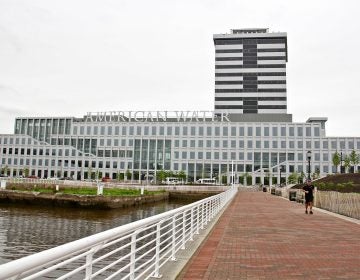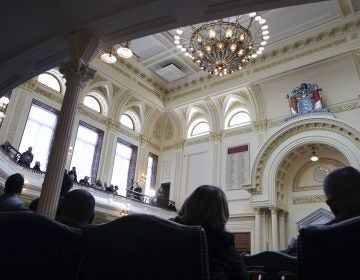How companies and allies of one powerful Democrat got $1.1 billion in tax breaks
Meet George Norcross. Nearly two thirds of $1.6 billion in tax incentives in his hometown of Camden, New Jersey, went to his own company, business partners, political allies.
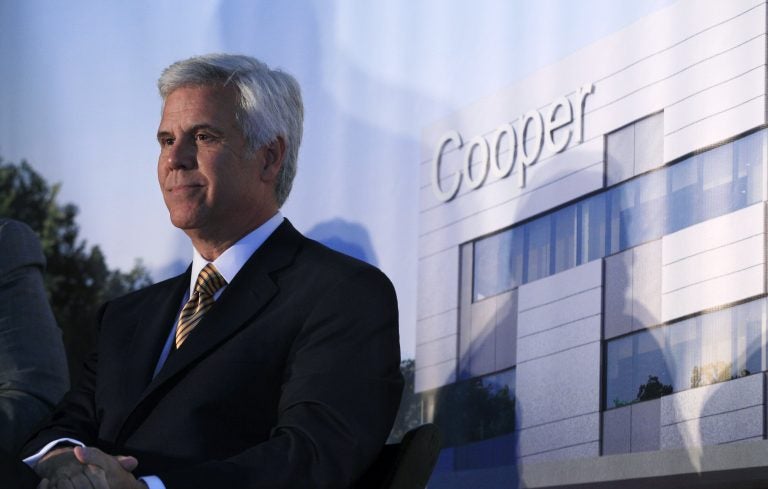
George Norcross III during a groundbreaking ceremony for the Cooper Cancer Institute. (Mel Evans/AP Photo)
This article was produced in partnership with WNYC, which is a member of the ProPublica Local Reporting Network. It was co-published with The Star-Ledger.
On a blustery day here in early March, a waterfront amphitheater in one of America’s poorest cities became the unlikely venue for a rare public performance by New Jersey’s top political boss.
George E. Norcross III, a silver-haired insurance broker who is widely regarded as the most powerful unelected official in New Jersey, showed up at the BB&T Pavilion in Camden to tout the “rebirth” of his long-suffering hometown and praise the state tax break program that made it possible.
“It looks to me like the state got a pretty good deal,” said Norcross, standing before projected photos of children cavorting in what appears to be an idyllic Camden, only blocks away from streets lined with dilapidated buildings.
In an interview a few weeks later, Norcross called himself “one of the loudest cheerleaders” for the embattled tax break program. “I’m certainly very proud to be part of it,” he said.
Norcross and his associates have reaped substantial benefits from the tax breaks. Of the $1.6 billion in tax breaks for companies that agreed to make a capital investment in Camden, at least $1.1 billion went to Norcross’ own insurance brokerage, his business partnerships and charitable affiliations, and clients of the law and lobbying firms of his brother Philip, an investigation by WNYC and ProPublica found.
Reporter Nancy Solomon digs deeper into Norcross’ involvement in the Economic Opportunity Act on Thursday’s episode of WHYY’s The Why. Listen now and subscribe on Apple Podcasts or Stitcher.
Camden reaped more than four times as many tax breaks as the combined amounts of other cities designated as “growth zones,” according to data from the New Jersey Economic Development Authority.
Many of those benefits are a direct result of state legislation that Norcross was instrumental in getting passed in 2013. One influential lawmaker remembered the bill as “George’s baby.” Philip Norcross helped draft key amendments in 2014, and brother Donald Norcross — then a state senator and now a member of Congress — co-sponsored the bill.
A panoramic view of the waterfront shows the range of Norcross’ influence within the program, which is run by the state Economic Development Authority and is now in the crosshairs of Democratic Gov. Phil Murphy.
On the banks of the Delaware River, a soaring 15-story tower will be the new headquarters of Norcross’ company, Conner Strong & Buckelew, and its partners, The Michaels Organization and NFI LP. All three companies are moving to Camden from the suburbs, a little more than 10 miles away.
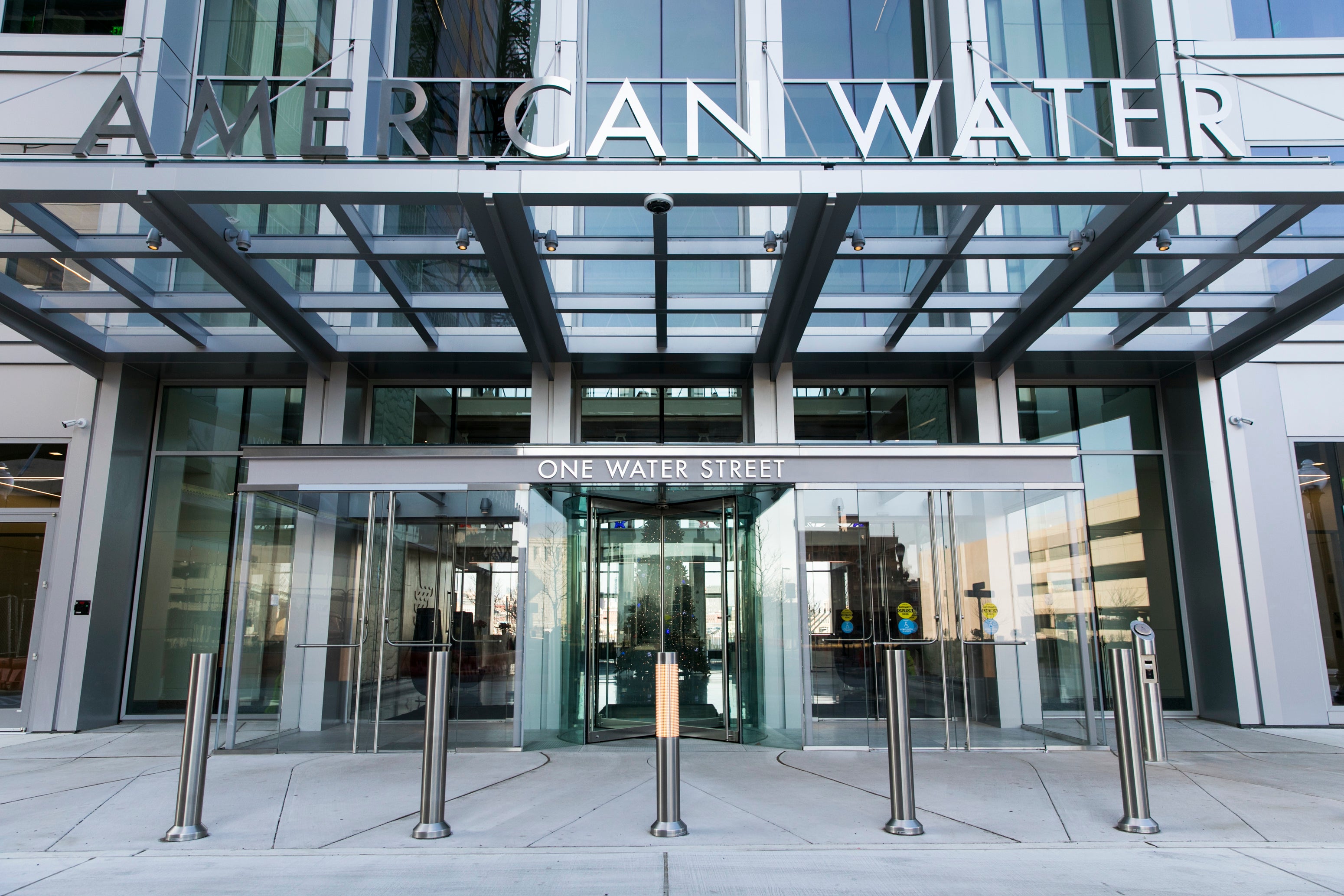
The project won tax breaks worth $245 million to be doled out over the next 10 years — a one-for-one match for the total cost of the construction — beginning when the companies show they have moved some 900 employees to Camden. An additional $20.4 million tax break went to the same Norcross business partners, The Michaels Organization and NFI, to construct a luxury apartment building nearby that, when finished, would allow tower employees who rent there to safely walk a short distance to work.
Camden’s crime rate is the second highest in New Jersey, and few workers walk to the waterfront complexes that are already open. Shuttle buses carry them from a local transit stop to gleaming buildings rising from vacant lots. From her apartment, community activist Sue Altman, a political opponent of Norcross, watches as “every morning a lot of cars drive in and every evening a lot of cars drive out.” Colandus “Kelly” Francis, the chair of Camden’s NAACP and a local community development group, contends the suburban workers infuse little money into the local economy.
“They are not moving into Camden, and they do not shop, they do not stay in Camden,” he said. “They come in at 9 and they leave at 5. Camden downtown at 5 o’clock is a ghost town.”
A visit on a late Friday afternoon in April tallied with their impressions, with empty train station platforms and downtown streets leaving a deserted urban landscape as a clock registered 5:13 p.m.
On the riverfront next to the Norcross tower sits the new glass-and-steel headquarters of American Water, a giant public utility represented by Optimus Partners, a lobbying firm owned by Philip Norcross. The water company has paid Optimus $854,000 since 2012, records show.
The company won $164 million in tax breaks. CEO Susan Story told NJ.com last year that George Norcross encouraged the move to Camden. “And we’re here. Thank you, George,” she said. She declined an interview request.
$79.4 million: Amount in tax breaks granted to The Michaels Organization. Conner Strong is a business partner with Michaels.
Just down the road, the Philadelphia 76ers built a “mecca of basketball” that houses a new practice court and corporate headquarters. Philip Norcross’ law firm, Parker McCay, represented the team in securing an $82 million tax break. A 76ers spokeswoman and Norcross declined requests for comment.
Nearby, Holtec International makes storage casks for spent nuclear fuel. Holtec won tax breaks worth $260 million, the second-largest total in New Jersey history.
George Norcross is an unpaid member of Holtec’s board, and his insurance brokerage shared a $400,000 contract for construction insurance at the Holtec site, according to documents in a lawsuit over the project. Joy Russell, senior vice president of business development and communications at Holtec, said the company supports George Norcross “and all that he has done for Camden.”
Norcross bristled when asked in an interview how many of the businesses that received tax breaks are his insurance clients.
“If you’re suggesting that, for some reason, Conner Strong, by virtue of moving to the city of Camden, somehow miraculously is making money here, you’re misinformed,” Norcross said. “We’re taking an enormous risk here. We could have moved anywhere in the country, enjoyed many different states’ incentive programs.”
In a lengthy response to questions, a Norcross spokesperson said Wednesday, “George Norcross has invested over $100 million of his company’s and his family’s money in Camden’s future. While it is true that some of the projects in which he has invested has received approval for an award, neither he nor any company from which he receives compensation has received a tax credit award, although they have been approved for them in future years subject to review and certification the projects met their obligations.”
The New Jersey law offered special incentives to investors willing to put money into Camden and other “distressed” South Jersey cities. The goal was to stimulate the creation of jobs, and some research suggests it has done so. But some Camden activists complain that not enough jobs have gone to local residents.
And now, the tax break program is under scrutiny as the latest example of political influence in New Jersey, where Norcross has been a kingmaker for at least 20 years.
Special breaks for the boss’s hometown
The most detailed study of the program came in a state-commissioned report by researchers at Rutgers University in 2018. The study found problems across New Jersey in how the tax breaks have been administered.
But its most pointed criticism focused on 13 projects it dubbed “the Camden alternatives,” which it said appeared to be excessive uses of taxpayer money for limited job creation.
Camden’s median annual household income hovers around $26,000. Every job created in the Camden alternatives would cost taxpayers $34,000 a year — a staggering $340,000 per job over the 10-year life of a grant, according to the Rutgers study. By comparison, the average cost per job in the program around the rest of the state is about $5,000 per year.
“You get these numbers that jump out and you say, ‘Wait a minute,’” said Will Irving, an economic analyst at Rutgers who co-authored the 2018 review. The researchers said they came to understand that the Camden awards were so lucrative for a simple reason — the law allows it.
Norcross has a link to at least nine of the 13 “Camden alternatives,” according to the WNYC-ProPublica investigation.
Murphy ordered an audit and, this year, named a special task force to dig into the EDA’s operations. Murphy appointee Gurbir Grewal, the attorney general, launched his own inquiry and said in a statement that he intends “to figure out what exactly happened and whether any laws were broken.”
Investigators have indicated publicly they are going back to the beginning of the legislative process, but it is unclear whether they are focusing on Norcross or his brothers. They have homed in on the Legislature’s passage of the 2013 law and amendments giving advantages to Camden and other locations.
The governor’s task force is also investigating claims made by whistleblowers who say that companies falsely threatened that they would move out of state, and that the EDA was pressured into approving applications by the administration of former Republican Gov. Chris Christie.
$260 million: Amount in tax breaks granted to Holtec International, where George Norcross is a board member.
The program is governed by complex rules and financial calculations that have evolved over time. To qualify for a tax break, companies must make a capital investment in a new factory or office in one of about 80 “distressed” towns or other designated areas in New Jersey. They must promise to create at least 10 new jobs or retain 25 that would otherwise move out of state.
In return, the companies can deduct a portion of their investment from their state tax bills each year. The exact amount is based on a complex cost-benefit analysis of their application. They typically get a portion of the overall tax credit each year over 10 years, starting when the capital project is complete. They have a maximum of four years to finish construction.
Companies must certify their employment levels each year in order to receive the tax credit. A “clawback” provision requires them to maintain at least 80% of their target employment level for the duration of the program and five years after it expires — or pay some money back.
The program allows companies to sell their tax credits to other companies for no less than 75 cents on the dollar, cash. They can also bundle them into securities and sell them to raise working capital. Still, they are required to maintain their promised employment levels or return money to the state.
The rules became even more nuanced in projects targeted for localities known as Garden State Growth Zones, distressed areas like Paterson, Passaic, Trenton and Atlantic City. The state required a lower minimum investment and lower numbers for job retention and creation there.
The incentives to move to Camden were even more generous. Companies did not have to promise as many new jobs and would be eligible for a maximum award of $35,000 per job every year — $5,000 more than the maximum allowed anywhere else. Large projects, with at least 250 jobs and $30 million capital investment, would have no award limit.
Depending on the cost-benefit analysis, companies moving here are also eligible for a dollar-for-dollar match against their initial capital investment.
The rules left room for interpretation on a key point. In applications for every other New Jersey city, the EDA required certifications from companies that they planned to leave the state unless New Jersey granted them tax breaks. Applicants in Camden only had to certify that the tax breaks were necessary for them to move jobs into the distressed city.
It is unclear why Norcross’ company went the extra step and submitted materials to show that it was considering an out-of-state move to Philadelphia unless the tax break was awarded. Its application included a cost analysis and photographs of a potential location just across the river. Conner Strong CEO Michael Tiagwad certified that the firm “will not make the contemplated capital investment in the city of Camden without the requested tax credit.”
The EDA staff recommended its board approve the Conner Strong tax break. “The applicant has certified that the 157 New Jersey jobs listed in the application are at risk of being located outside the state,” the report said.
Asked by WNYC and ProPublica why his company would threaten to leave New Jersey, Camden’s native son and biggest booster suggested that a reporter misread the rules.
$86.2 million: Amount in tax breaks granted to Conner Strong & Buckelew, where George Norcross is executive chairman.
“That program is intended simply to encourage people to move to those cities. That’s it. It doesn’t contemplate, ’Oh, are you thinking about moving out of state,”’ George Norcross said.
He did not explain why Conner Strong and several other companies submitted certifications that they might move to Philadelphia if they did not need to do so. What is important, Norcross said, is that he and his business partners invested $300 million of their own money to build in Camden and won’t get it back unless they maintain their employment commitments.
Jim Walden, a former federal prosecutor who is leading the governor’s task force, said his team will examine how the EDA interpreted the program rules about “alternate sites” at the time the applications came in.
Working-class boy makes good
Norcross, 63, is no ordinary party boss. A lifelong Democrat who sits on the Democratic National Committee, he was born in Camden and learned politics at the knee of his father, a union leader. A college dropout, Norcross started an insurance brokerage while also working in local politics, eventually becoming chairman of the Camden County Democratic Committee.
He built his company into one of the nation’s largest insurance brokerages, which also has international clients, according to its website. He was listed by NJBiz in 2015 as one of the state’s wealthiest men, with an estimated fortune of $248.5 million.
A member of the exclusive Mar-a-Lago Club in Palm Beach, Florida, he brought his friend, Donald Trump, to inspect the $10 million Florida home he bought years ago on the Intracoastal Waterway. Trump called the house “spectacular, an exquisite location,” Norcross told The Palm Beach Post in 2006.
His relationship with Camden is complicated. He does not live in the city, according to state property records, which list a $1.4 million Cherry Hill estate as his residence. But he has been one of the neglected city’s major philanthropists. He said in an interview that he had “a strong interest in being a part of the community that we had grown up in and been a part of.”
He chairs the Camden-based Cooper Health System, Cooper Hospital and the local outlet of the Texas-based MD Anderson Cancer Center. Philip Norcross also serves on the board, as did their late father. Donald Norcross was a union leader until he was elected to the state Senate in 2009 and the U.S. Congress in 2013.
George Norcross’ influence over New Jersey’s Legislature is well established, as are his hardball tactics. Most lawmakers interviewed for this story declined to discuss him publicly, saying they fear losing his political support or other repercussions.
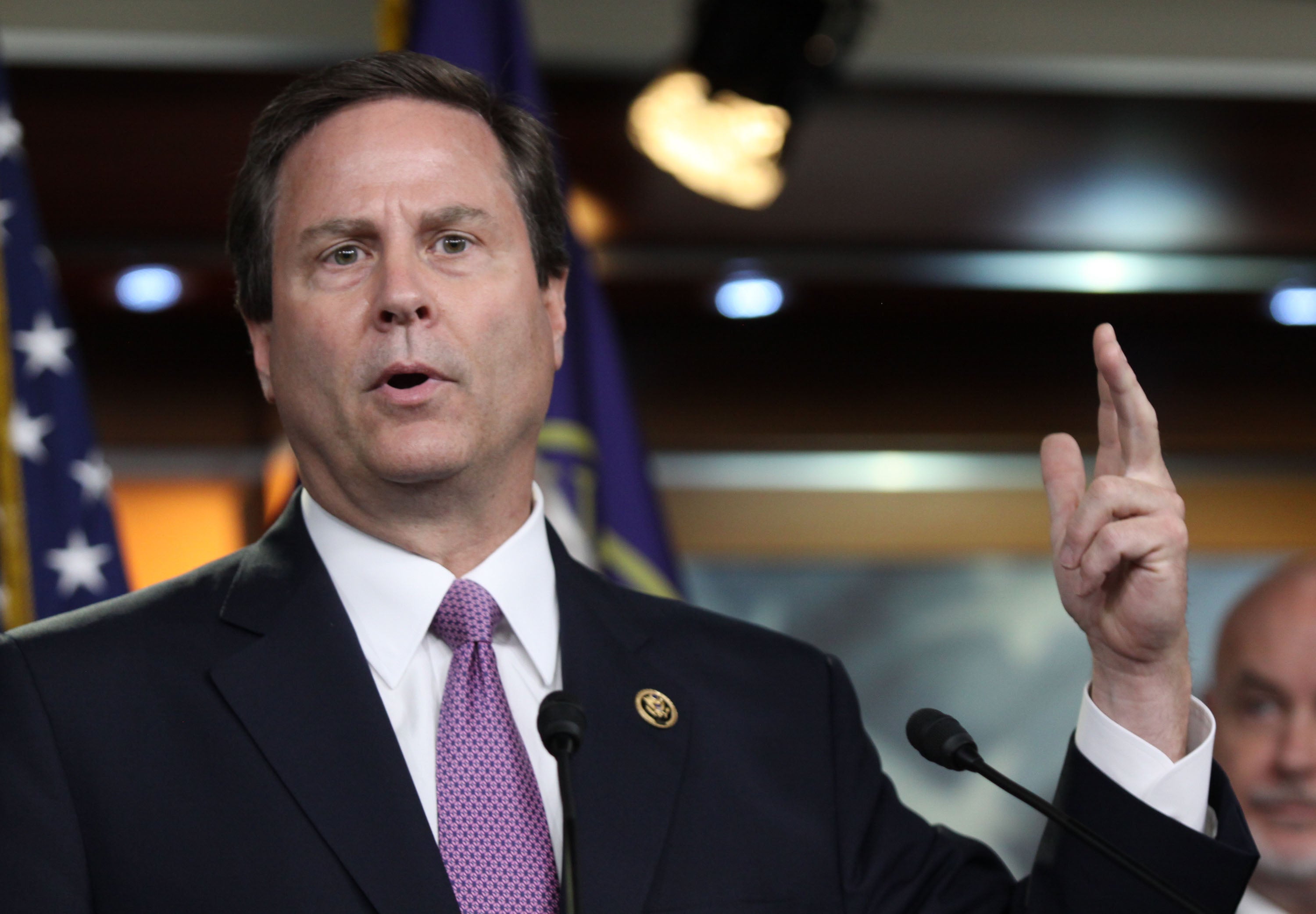
In 2005, as part of a lawsuit that was ultimately dismissed, more than 300 hours of tape recordings became public, revealing private conversations between Norcross and Burlington County officials. The tapes, which were widely publicized, featured blunt talk from Norcross about his political connections and ability to influence state contracts.
“In the end, the McGreeveys, the Corzines, they’re all going to be with me. Not because they like me, because they have no choice,” Norcross said, referring to two former New Jersey governors.
For several decades, the Norcross political machine has picked local, federal and state candidates, funded their campaigns and used labor union alliances to get out the vote. His network rallied to elect his brother to Congress.
How the sausage was made
New Jersey’s tax break program began in 1996 but grew massively two decades later under Christie. The Legislature passed the Economic Opportunity Act in 2013 and updated it the following year with a goal of jump-starting economic development.
“Let’s not kid ourselves. We’re competing with other states every day for the economic pie,” Christie said at a news conference.
Norcross said in an interview that he played little role in the legislation, but his influence is one of the worst kept secrets in Trenton. Even Christie, with whom Norcross formed a bipartisan alliance, credited him in his final State of the State speech in 2018.
“None of this could have been done without the relentless will of George Norcross,” Christie said, nodding to the front row, where Norcross was sitting.
“I can’t believe it, but I am honored to have George here today,” Christie said to ripples of laughter about their bipartisan relationship. “And even more honored to call him my partner in this rebirth of Camden — we did it, George!”
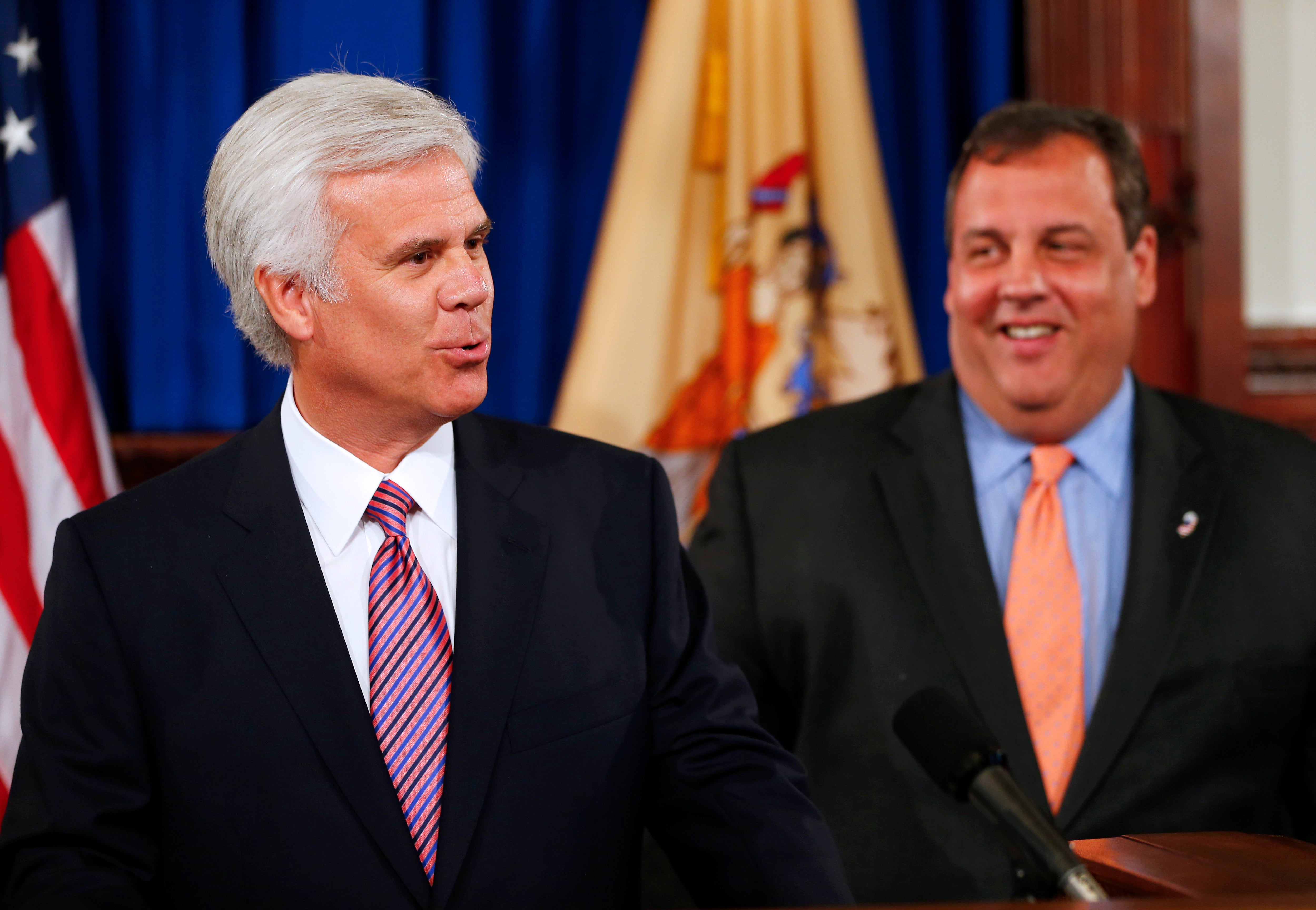
Lobbyist and lawyer Philip Norcross said in a Wall Street Journal interview that he helped write the 2014 amendments to the legislation.
At least six clients of his law or lobbying firms later obtained more than $768.6 million worth of tax credits.
He declined an interview request. In an emailed statement, a law firm spokesperson said: “We are proud of the role Parker McCay has played in helping to move Camden forward and even more proud of the hard work so many of our neighbors have played in Camden’s continued rise.” Optimus did not respond to questions.
Donald Norcross, then a state senator from Camden, co-sponsored the original bill. In the final days of that year’s session, members tacked on amendments to address local interests and added incentives targeting South Jersey, especially Camden. The bill changed the rules for tax incentives going to Camden, Trenton, Paterson, Passaic and Atlantic City.
The new incentives inflated a 47-page bill to more than 80 pages.
Some lawmakers told WNYC and ProPublica they felt pressure from legislators who are allies of Norcross’ to pass the 2013 bill although they believed it gave Camden an unfair advantage. Not only did the new law make it easier for Garden State Growth Zones to qualify for tax incentives, but the bill included numerous provisions for companies located at sites that were thinly veiled locations in Camden, describing them as a certain distance from a port and a rail line and other characteristics of the city.
For example, the law allows a real estate developer to apply for a tax break if it is involved in “any project in the City of Camden and Atlantic City that includes a retail facility of at least 150,000 square feet, of which at least 50% will be occupied by a full-service supermarket.”
One such developer, The Goldenberg Group, was involved in a project to bring a supermarket to Camden that never came to fruition. The developer is a client of Philip Norcross’ lobbying firm, Optimus.
“It was a rushed 48-hour process where that bill changed,” said Sen. Joseph Cryan, D-Union. “It was a large bill. There was no time to even read it thoroughly nor obviously vet it.”
Companies in depressed areas of South Jersey would be allowed to create 25% fewer jobs and invest one-third less in new projects than firms elsewhere in New Jersey. To reward new job creation, they would be eligible for a special $1,000 credit per job.
$79.4 million: Amount in tax breaks granted to NFI. Conner Strong is a business partner with NFI.
Cost-benefit benchmarks used to determine basic eligibility for the program also were softened for Camden.
To reach the Senate floor, the bill needed support from the chamber’s president, Stephen Sweeney, a Democrat. Sweeney and Norcross are childhood friends and, according to a person familiar with their interactions, Norcross frequently weighed in with Sweeney on legislative issues.
Norcross denied playing a critical role in passage of the legislation.
He said there “were dozens and dozens of people involved in legislation. We were all community activists involved in this because it was a good thing for Camden, Passaic and Paterson, and Trenton and Atlantic City.”
Sweeney did not reply to several requests for an interview.
Sweeney won help in locking down the South Jersey amendments, including the Camden breaks, from Sen. Ray Lesniak, a Democrat from Union County, in North Jersey. Lesniak, chairman of the Committee on Economic Growth, was the prime sponsor of the bill in the Senate.
In interviews, Lesniak said he initially fought with Sweeney over many of the amendments but eventually agreed — even though his own hometown, Elizabeth, also among the poorest in New Jersey, was not included.
“Camden was where the most help was needed,” Lesniak said.
He broadly defended the tax break program, saying that the incentives clearly preserved jobs that would have left the state. “Basically, the facts are very simple: Without these tax incentives we will lose revenues,” Lesniak said.
Just weeks before approving the final amendments, Lesniak, who was then in a tough primary election battle, received help from a Washington, D.C.-based political action committee for which Norcross has raised money. The committee, then known as the Fund for Jobs, Growth and Security, spent $35,000 on Lesniak’s behalf for direct mail and other services, records show.
Lesniak said the spending did not influence his support for the Camden tax breaks.
“I wish he had given me more, especially after what I have done for the city of Camden,” Lesniak told WNYC and ProPublica, referring to George Norcross. “This was the poorest city in the country. This was a city that needed help. Now look at what’s going on down there. George has been the champion for all that.”
Lesniak’s hometown, Elizabeth, is larger than Camden, but it didn’t get much love from the bill. While Camden raked in $1.6 billion from the special incentives, Elizabeth got a total of $47.9 million, according to state data.
Implementing the program
With the program up and running, state officials came under increasing pressure to make it work.
In 2015, a whistleblower filed a lawsuit in Mercer County Superior Court claiming that he was improperly fired as an EDA finance officer for complaining about program abuses. The official, Veyis “David” Sucsuz, said he was ordered to change data on some applications that he did not believe qualified under program rules.
In a deposition, another top official testified that the Christie administration “wanted to take me out back” for being a stickler about the rules.
Sucsuz lost his suit. A jury found he had not presented enough evidence that he was fired because of his complaints.
After his firing, the EDA replaced him with Mark Chierici, who had worked at American Water for the previous three decades. The company, represented by Philip Norcross’ lobbying firm, received a $164 million tax break to move its headquarters to the Camden waterfront.
$164.2 million: Amount in tax breaks granted to American Water, listed as a client of Optimus Partners, a lobbying firm owned by Philip Norcross.
The EDA says Chierici recused himself from decisions related to his former employer’s application. But he signed off on other applications, including the three by George Norcross and his two business partners. A spokesperson for George Norcross said he does not know Chierici.
Chierici did not respond to requests for comment. Virginia Pellerin, the EDA spokeswoman, said the process of hiring him was rigorous.
“To Mark’s knowledge, no elected official or American Water employee played a role in his application or selection for this position,” she said in an email to WNYC and ProPublica.
Neither George nor Philip Norcross are elected officials or employees of American Water. Neither had a role in recommending Chierici for the job, the EDA said.
Pellerin said no application moved forward “without consistent, clear documentation of the benefits to taxpayers.”
Murphy and Norcross are both Democrats but are not necessarily allies. Norcross backed his friend Sweeney for governor in the 2017 Democratic primary.
Murphy has called on members of the EDA board to resign, following a demand by more than 50 organizations. Many of the board members have connections to either Norcross, Sweeney or Christie. Sweeney has pushed back against Murphy, defending the board’s performance and vowing to re-nominate current board members to the seats that he controls.
Camden Mayor Frank Moran says the program is contributing to the city’s revival.
“Our neighborhoods have become tremendously, measurably safer, our schools decidedly stronger and our economy more robust,” he said before introducing George Norcross at the March event on the waterfront. “We’ve reached new heights in innovation across sectors, and we know the best is yet to come for our great city. Camden is truly rising.”
But the Rutgers study singled out the 13 “Camden alternatives” for criticism because it said they returned little net benefit back to taxpayers.
For example, it noted that the Camden tower under construction by Norcross and his two partners would bring 884 jobs to the city. But the total cost to taxpayers over the 10-year life of the program would come to $277,145 per job, more than than five times the state average, the researchers found.
Brothers, in law
Philip Norcross and his law firm, Parker McCay, have consulted for a string of tax break applicants that have won some of the biggest awards approved under the tax incentive program. That’s in addition to the work done by his lobbying firm for American Water.
The law firm’s website promotes its work in winning incentives for clients that match the description of Holtec, Subaru and the 76ers, which collectively have been granted $459 million in tax breaks.
“We are the premier counsel in the State of New Jersey in matters involving tax credits,” the firm proclaims. “We advise clients on every step of the process with the New Jersey Economic Development Authority. We have obtained hundreds of millions of dollars for our clients.”
That includes a $40 million tax-break for the Camden campus of Cooper Health System, where both George and Philip Norcross sit on the board. The 142-year-old nonprofit said it would use the money to expand back-office operations in the city. George Norcross has been the system’s chairman since 2006.
The EDA approved the application in December of 2014, two months after Christie signed a law that allowed nonprofits to take part in the incentive program. Kevin O’Dowd, Christie’s former chief of staff, left government to become executive vice president of Cooper Health the following month.
In its application, Cooper warned that the 353 back-office jobs, at sites in Mount Laurel and Cherry Hill, were at risk of being moved to Philadelphia unless the state supplied the tax breaks.
$39.9 million: Amount in tax breaks granted to Cooper Health System, where George Norcross is chairman of the board of trustees.
But nonprofits do not pay the corporation business tax and the insurance premiums tax at the center of the program, according to the state Treasury Department. Instead of taking the credit, Cooper sold its tax credits for 93 cents on the dollar to Horizon Blue Cross Blue Shield.
George Norcross says that’s the genius behind the program: The state can provide an incentive that can be converted to cash, which makes it that much more valuable.
“Some of the major corporations in the state of New Jersey that have already gotten tax credits have sold them,” Norcross said. “It’s simply a way to provide the incentive, that’s all.”
The cost of change
New Jersey is now dealing with the ripple effects of a tax incentive program that will cost about $1.6 billion in current and future forgone tax revenue. It is being openly criticized as too generous given the state’s fiscal pressures.
In Camden, money woes are especially intense. The school district, for example, recently announced it is facing a $27 million deficit and plans to close two schools and relocate 900 students.
There is no independent data to verify how the tax incentive program has impacted jobs for Camden residents.
An audit released in January by the New Jersey State Comptroller said the EDA “lacks an adequate monitoring system” to assess whether promised jobs have been created.
Francis, the local NAACP leader, said he believes the vast majority of jobs created by the program have not gone to Camden residents. A Norcross spokesperson called Francis a “long-term critic of the important changes being made in Camden.”
“This is a predominantly low-income community, and most of the people are not college educated,” he said. “So they need entry-level jobs in order to be able to advance and move up the economic ladder.”
Six years after the law was passed, construction is nearly complete at the new headquarters of George Norcross’ insurance brokerage.
“This is the first thing that was needed to happen, to move people to the city of Camden in order to help create jobs and create an influx of activity in the city which would hopefully draw some private capital investment,” Norcross said.
The plan submitted to the EDA said the building will house retail and restaurant space, a cafeteria, fitness center, a restricted parking garage and a rooftop heliport. Norcross’ company will occupy the building’s top three floors, which offer an unobstructed view of the Philadelphia skyline on one side and the clock tower atop Camden City Hall on the other.
The offices will house workspace for 172 people who currently work in the Camden suburbs and 98 who now work in Philadelphia.
A construction worker from Camden at the site in April said the building has many luxury touches.
One of the best spaces, he said, is the one workers simply call “George’s office.”
Alex Mierjeski and Lylla Younes contributed to this report.
This report was produced with support from the McGraw Fellowship for Business Journalism at the Craig Newmark School of Journalism, City University of New York.
Update, May 1, 2019: Following the publication of a story by WNYC and ProPublica on George E. Norcross III and a subsequent story by The New York Times on a lawyer’s involvement in the writing of legislation creating an economic incentive program, New Jersey Gov. Phil Murphy issued this statement:
“I am deeply troubled by the findings outlined in both the WNYC report this morning and the New York Times story this afternoon. Coupled with what we already know about how the tax incentive program operated over the past six years, I believe now more than ever in the importance of the task force I commissioned.
“Until we’ve taken a good hard look at the entire process, I don’t believe we can be sure that all taxpayer money has been properly spent and accounted for. If there was fraud in this program, I expect the task force will uncover it and those individuals will be held accountable.
“Given the breadth of these findings and those so far reported by the task force, I believe anything short of a total revamp of the tax incentive program is a disservice to the hard working taxpayers of New Jersey.”
Update, May 1, 2019: Following publication of a WNYC-ProPublica story on George E. Norcross III, he issued this statement:
“As one of the foremost champions of Camden’s renaissance, I join with other Camden leaders to thank WNYC Radio for its lengthy story detailing the massive undertaking to help rebuild Camden’s future. While much of the story has previously been reported by other outlets, this was the first effort to compile all of the hard work that went into getting the city on its current path forward. The story reported that there is at least $1.6 billion of new private sector investment in a city that was on its good days merely ‘struggling.’ Now, government statistics reveal that jobs and graduation rates are up, while crime, unemployment and poverty are down.
“In its reporting, WNYC highlighted the legislative back and forth that reformed the Grow NJ Program in 2013 to ensure that Camden, America’s poorest and most dangerous city, was given the tools it needed to attract the private investment needed to rebuild the city’s tax base. Due to an unprecedented partnership between residents, government, business and community leaders, Camden ‘reaped more than four times as many tax breaks as the combined amounts of other cities designated as “growth zones,” according to data from the New Jersey Economic Development Authority.’”
“But even with the surge of interest and investment in Camden, the record is clear: over the last two decades and until recently, Camden and South Jersey have received just a small percentage of the state’s economic incentives while companies like Goldman Sachs, UPS, Siemens, Forbes, JP Morgan, Prudential, Panasonic, and Verizon received eight and nine-figure tax credits for locations in North Jersey. The $1.6 billion for Camden projects identified by WNYC is just a fraction of the $5 billion recently committed to Amazon if it would move to Newark.
“The fact that private investment is returning to Camden is no accident — it was planned and fought for. As WNYC and other media outlets have reported, the commitment to rebuilding Camden’s future began years ago and focused on the city’s three biggest challenges: improving public safety, reforming education and bringing jobs and economic investment to the city.
“According to government statistics, total crime is down by almost 59% since 2012, graduation rates have jumped by almost 20 points while the dropout rate has been cut in half, unemployment is down 8 full points and poverty is being reduced. While the work is not done, but all accounts the city is making real progress. That’s why, when President Barack Obama toured the city, he praised it as a “symbol of promise for the nation.”
“As the WNYC story makes clear, this dramatic change wasn’t due to luck or happenstance. It is the product of thoughtful planning and hard work by many people over the course of almost a decade. We are not nor will we be deterred from realizing the full potential of this great city for its residents, and businesses. Camden is truly Rising.”
ProPublica is a Pulitzer Prize-winning investigative newsroom. Sign up for The Big Story newsletter to receive stories like this one in your inbox.
WHYY is your source for fact-based, in-depth journalism and information. As a nonprofit organization, we rely on financial support from readers like you. Please give today.


